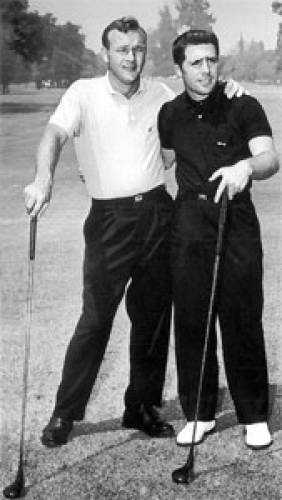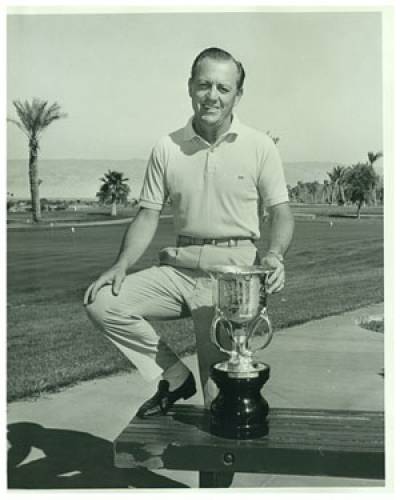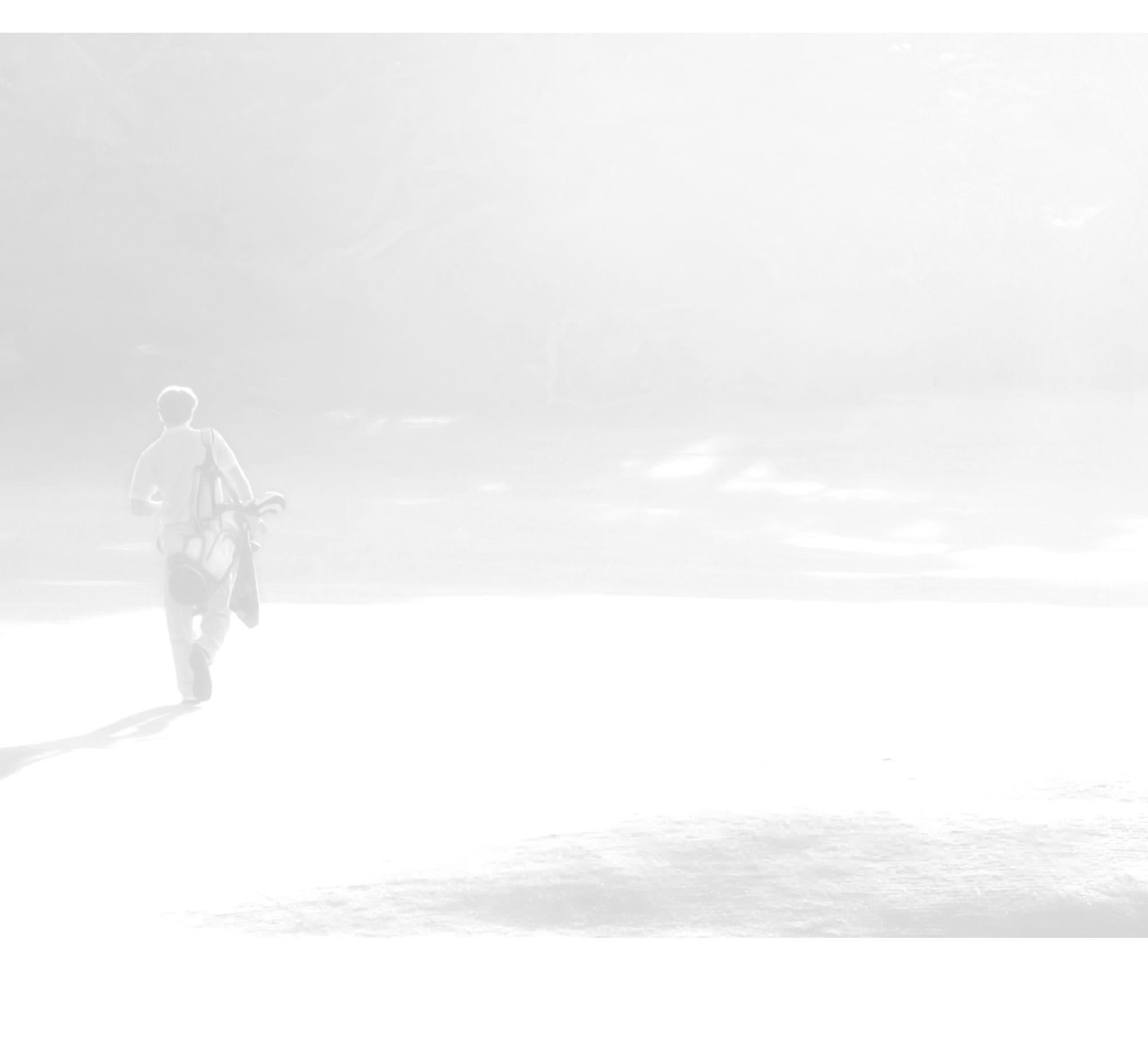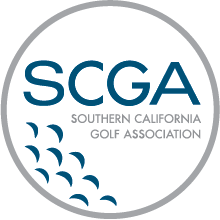SCGA History
Part 4: 1960-1979
- Chapter 1: Handicapping: From Index Cards to Computers
- Chapter 2: The Newell Pinch era begins
- Chapter 3: A New Membership Policy
- Chapter 4: FORE Magazine: Reaching Out to All Members
- Chapter 5: Beginning to Build Golf House West
- Chapter 6: Building Golf House West
- Chapter 7: An Ever-Growing Tournament Schedule
- Chapter 8: Merging with San Diego
- Chapter 9: A New Era
- Epilogue: New Horizons
SCGA History: Part 4
Prologue -- Shattered Dreams
 As 1960 dawned, Americans had good reason to believe that a bountiful era was at hand. For the first time in nearly a decade, no Americans were fighting abroad. The 1950s had been a decade of prosperity (that is, if you were Anglo), inventions and innovations. Three out of every four houses had a television (a percentage that was rapidly increasing each year). The interstate highway system had ushered in the automobile era and more and more Americans were moving to suburbia.
As 1960 dawned, Americans had good reason to believe that a bountiful era was at hand. For the first time in nearly a decade, no Americans were fighting abroad. The 1950s had been a decade of prosperity (that is, if you were Anglo), inventions and innovations. Three out of every four houses had a television (a percentage that was rapidly increasing each year). The interstate highway system had ushered in the automobile era and more and more Americans were moving to suburbia.
Nowhere was that truer than in Southern California. Houses and housing tracts - indeed, whole new cities - were springing up almost overnight. Freeways were being laid as quickly as possible (bulldozing, among other things, the region's once thriving rail rapid transit network known as the Red Cars). Cheap gasoline made it possible for people to drive wherever they wanted for work or pleasure.
The economic boom was also felt in the golf community. More than 150 golf courses were built in Southern California from 1960-1979, ranging from modest municipal layouts to elaborate country clubs. Golf course communities began to spring up, not all of which survived; many developers were simply a decade or so ahead of their time and some of the courses (and their surrounding communities) went by the wayside.
The "baby boomers" were having children of their own in record numbers and the whole society began to take on a more youthful look. Nowhere was that better symbolized than when John F. Kennedy became the youngest person ever to be elected President of the United States. It was a run that many thought would never end . . . until a sunny day in Dallas, Texas.
Perhaps America came of age on November 22, 1963; it certainly turned a page in its history and entered a turbulent era.
Led by a charismatic preacher named Martin Luther King, Jr., the civil rights movement ushered in new rights for all Americans. The movement was too fast for some, not swift enough for others. King was eventually assassinated.
 The nation did slide slowly into another war, this time in an area of the world hardly anyone knew about before 1960: Vietnam. We landed men on the moon, saw another Kennedy assassinated and watched Richard Nixon resign in 1974 as U.S. President. Along the way, we entered the computer age and never even noticed as a new disease appeared: AIDS.
The nation did slide slowly into another war, this time in an area of the world hardly anyone knew about before 1960: Vietnam. We landed men on the moon, saw another Kennedy assassinated and watched Richard Nixon resign in 1974 as U.S. President. Along the way, we entered the computer age and never even noticed as a new disease appeared: AIDS.
The nation grew up in those 20 years. So did the golf community.
After the successful fight to pass Proposition 6 (which helped guarantee fair taxation for golf course and other recreational facilities), the SCGA began to mature into an organization that did more than just rate golf courses and conduct tournaments. Although the seeds of that growth were sowed by boards in the 1940s and 1950s, it was in the 1960s that the SCGA began to implement programs that would have long-term impacts on all golfers throughout the association.
Chapter 1 -- Handicapping: From Index Cards to Computers
Perhaps the most far-reaching program that the SCGA would institute would be association-wide handicapping, which began in the 1960s.
Prior to that time, each club kept its own handicap records, often on minutely detailed index cards (no latter-day pun intended) and often overseen by a single person who would be the club's handicap chairman for years.
But as the number of clubs began to grow rapidly through the 1950s and beyond, the problems also began to escalate. For one thing, not every club (especially new ones) was able to find someone who was willing to devote the hundreds of hours each month necessary to keep records. Equally important, clubs were becoming increasingly unwilling to accept handicaps from other clubs. By establishing an association-wide handicapping system, the SCGA sought to address both of those issues.
As computers began to become available (although the giant machines were for use only in large companies), several firms began offering "computerized" handicaps in Southern California ("mechanically calculated handicaps" might be a more accurate term). The SCGA's handicap committee, headed by Director Charles Laws (who would become SCGA president in 1964), not only undertook a review of those companies but also explored whether the SCGA should simply employ people to calculate handicaps on its own.
 The study took several years. As to the question of whether the SCGA should take handicap calculations in-house, Laws would make a statement to the board that was both accurate for its time and remarkably prescient of the future (except for the dollars): board minutes indicate that Laws and his committee "hesitated to recommend the Association's investing 15 or 20 thousand dollars in a system that might be obsolete in two weeks or two months."
The study took several years. As to the question of whether the SCGA should take handicap calculations in-house, Laws would make a statement to the board that was both accurate for its time and remarkably prescient of the future (except for the dollars): board minutes indicate that Laws and his committee "hesitated to recommend the Association's investing 15 or 20 thousand dollars in a system that might be obsolete in two weeks or two months."
Instead, in 1964, the SCGA signed its first contract with Integrated Data Company, one of the first firms to calculate handicaps using data processing. Under the arrangement, IDC began calculating handicaps for all SCGA clubs whose members were using the SCGA Handicap System.
In order to facilitate the posting of "away" scores, the SCGA developed a green "Away Score Posting Sheet" which soon became a familiar site at all golf course facilities.
The quest for uniformity in handicapping was well under way, but not without some difficulty. Several associations in the eastern United States did not use equitable stroke control in calculating handicaps and the USGA attempted to eliminate it nationwide. But the SCGA, led by another former president Lynn Smith, held fast to its position and eventually, equitable stroke control became a nationwide concept, as did the concept of using the low 10 out of the last 20 scores to compute handicaps.
In 1972, the Northern California Golf Association joined forces with the SCGA to create a statewide handicapping system, an agreement that was in place until 1990 when the NCGA elected to transfer handicapping to the USGA Golf Handicap and Information Network (GHIN).
Chapter 2 -- The Newell Pinch era begins
The rapid expansion of the SCGA, both in numbers of clubs and programs, brought changes to the staff, as well. For two decades, the association's day-to-day activities had been overseen by Executive Secretary Harold Dawson and one or two secretaries.
In 1962, Mel Gallagher, a public relations practitioner, was hired for a short time to assist in public relations and club relations. A year later, Ray Goates was hired in a new position, Executive Manager, where he would serve for two years.
Then in 1965, a young Iowa native named Newell Pinch took over as executive manager of the SCGA (a year later, his title was changed to executive director). During his tenure, the SCGA grew rapidly to become the nation's premiere regional golf association, implementing dozens of new and improved programs.
In an effort to reach out to all clubs, particularly those outside of Los Angeles, the SCGA began holding area and board meetings in other parts of the association. The board was expanded and members were elected from the northern coastal section, San Diego and the Coachella Valley.
Chapter 3 -- A New Membership Policy
One of the most important steps in the SCGA's growth took place when the board implemented an SCGA membership policy that included handicapping with every membership. For the past two decades, most members at SCGA clubs had taken advantage of the SCGA handicap, but it wasn't until 1965 that the policy became permanent. Dues were set at $6 per year.
"We needed to take this step," says Laws. "The concept of 'voluntary handicapping' was becoming harder to work with and made it very hard to create budgets for the SCGA. When we established an association-wide handicap system, it was time to fully integrate it into SCGA membership. It was one of the most important steps we could take."
Chapter 4 -- FORE Magazine: Reaching Out to All Members
Another important step was the establishment of FORE Magazine, the association's official publication.
Almost from the SCGA's beginning, outside parties had petitioned the board to have their publications serve as the SCGA's "official" journal, but each time the board elected not to go along.
However, by the 1960s, the board was realizing that being able to communicate with all members was becoming essential. "We just weren't able to get our message out effectively," says Lee Corwin, the SCGA director who headed the public relations committee in the mid-1960s and then became SCGA president in 1972. "Plus, we believed that our growing number of members made a publication not only desirable, but viable."
After spending hundreds of hours researching various possibilities, Corwin and his committee recommended, and the board accepted, a proposal to begin FORE Magazine in 1968. Peter Ueberroth (who would later head the 1984 Los Angeles Olympic Games and then become commissioner of baseball) and his partner, Wally Smith, eventually became the first publishers. USC golf coach Stan Wood and a Hollywood ad executive named Steve Gardner (who still sells advertising for the magazine) wrote copy for the initial issues; a prominent Anaheim attorney, Ralph Miller, contributed a three-part history on golf in Southern California. The first cover pictured SCGA President Gordon Booth with fellow Lakeside GC member Bob Hope.
Among other features, each issue contained the handicaps of each of the SCGA's 40,000+ members, a feature that was eventually dropped as the association continued to grow in size (to print all member' handicap indexes today -- even in very small type -- would take nearly 200 pages).
A year after it began publishing, the board accepted a proposal from an outside publisher who wanted to turn FORE Magazine into a monthly publication. However, that venture fizzled after five issues and the board quickly brought the magazine back in-house, hiring a respected public relations practitioner named Bill Elder to serve as editor and publisher. The magazine resumed publishing on a quarterly basis until 1985 when it went to its present bimonthly schedule.
Chapter 5 -- Beginning to Build Golf House West
As the SCGA's activities continued to expand, it was becoming increasingly apparent that the association needed to relocate its offices from downtown Los Angeles and a board study determined that the best way to accomplish that purpose would be to own its own building.
In addition, from the beginning discussions were held on whether the building could house not only the SCGA but all other golf associations in Southern California (the Southern California Section of the PGA, Southern California Public Links Golf Association, Women's Southern California Golf Association and the Southern California Golf Course Superintendents Association).
The first attempt was on land in the Silver Lake district of Los Angeles, where the board purchased a parcel of land on Silver Lake Blvd. and London St. But after drawing up plans for a two-story building featuring "free-standing portico units of white Medusa cement supported by eight columns of approximately 15-16 feet" and a reflecting pool, it was determined that the parcel wasn't big enough to support such a building and so it was sold.
The search continued with a couple of possible locations considered and rejected. Eventually, through the leadership of Director Sid Title (who became SCGA president in 1974), the SCGA's present location in North Hollywood, directly across the Hollywood Freeway from Universal Studios, was chosen.
In 1967, construction began on "Golf House West," which would, indeed, be the home of all Southern California golf governing bodies. Two years later, the building was dedicated; within the next two decades, the SCGA and the other associations would expand to the point where only the SCGA now resides at Golf House West.
Chapter 6 -- Building Golf House West
As the SCGA's activities continued to expand, it was becoming increasingly apparent that the association needed to relocate its offices from downtown Los Angeles and a board study determined that the best way to accomplish that purpose would be to own its own building.
In addition, from the beginning discussions were held on whether the building could house not only the SCGA but all other golf associations in Southern California (the Southern California Section of the PGA, Southern California Public Links Golf Association, Women's Southern California Golf Association and the Southern California Golf Course Superintendents Association).
The first attempt was on land in the Silver Lake district of Los Angeles, where the board purchased a parcel of land on Silver Lake Blvd. and London St. But after drawing up plans for a two-story building featuring "free-standing portico units of white Medusa cement supported by eight columns of approximately 15-16 feet" and a reflecting pool, it was determined that the parcel wasn't big enough to support such a building and so it was sold.
The search continued with a couple of possible locations considered and rejected. Eventually, through the leadership of Director Sid Title (who became SCGA president in 1974), the SCGA's present location in North Hollywood, directly across the Hollywood Freeway from Universal Studios, was chosen.
In 1967, construction began on "Golf House West," which would, indeed, be the home of all Southern California golf governing bodies. Two years later, the building was dedicated; within the next two decades, the SCGA and the other associations would expand to the point where only the SCGA now resides at Golf House West.
Historical Note: The SCGA Amateur Championship (1960-1979)
Chapter 7 -- An Ever-Growing Tournament Schedule
Despite the plethora of new programs and activities, the SCGA's historical programs continued to expand in popularity. Team Matches gained new entrants as clubs joined the association and by the mid-1970s the program had been split into Thursday and Sunday (later Saturday) sessions. The growth of golf in the Coachella Valley resulted in the Desert Team Championship beginning in 1978.
The rapidly expanding popularity of the PGA Tour had an impact on the SCGA Amateur Championship. For one thing, the final rounds of several tournaments in the 1960s were televised in Los Angeles on KTTV. The number of entrants continued to rise but from 1963 (when Bruce McCormick won the last of his three SCGA Amateur titles) until 1985, no player won the tournament more than once.
The California Amateur streak is even longer; not since Dr. Frank "Bud" Taylor won back-to-back California Amateur Championships in 1954-55 has a player successfully defended his title. SCGA winners of the state amateur included John Richardson in 1961, Mac Hunter in 1972 (at age 16 the youngest winner ever), John Cook in 1975, Lee Mikles in 1977 and Mark O'Meara in 1979.
In 1967, the SCGA joined with several other associations to revive the Pacific Coast Golf Association and the Pacific Coast Amateur Championship. The Pacific Coast Amateur had been contested for a few years at the beginning of the century and by the 1960s, there was a need to revive the event.
"We wanted to establish a tournament that would provide a chance for West Coast players to receive consideration for Walker Cup," recalls Pinch. The first event was held at Seattle CC and was won by Dr. Ed Updegraff (among the players he defeated was Fred Couples).
After struggling for a couple of years, the SCGA helped stabilize the organization and held the event for the first time in Southern California, at Lakeside GC in 1972. Among the tournament's winners in the 1970s was former USC Trojan Mark Pfeil, who won in 1972 and 1974 and played Walker Cup in 1973.
In 1971, the SCGA, in cooperation with the California Interscholastic Federation, began the SCGA-CIF High School Invitational with competition for boys and teams (a girls competition was added in 1982). A stocky, long-driving La Jolla high school student named Craig Stadler won the first individual event. The second was won by Barstow's Mark Johnson, the first of 14 SCGA-related titles that the latter would capture in his illustrious amateur career.
In 1975, the first SCGA Tournament of Club Champions was held at California CC, and in 1978, recognizing the growing number and quality of seniors in the association, the SCGA Senior Amateur was created and held at Wilshire CC. Fittingly, perhaps, two of the SCGA's greatest players, Ted Richards, Jr. and John Richardson won the first four senior championships (Richards won in 1978, 1980 and 1981; he would win again in 1984).
Historical Note: Major Accomplishments
Chapter 8 -- Merging with San Diego
Although the SCGA had always had several San Diego County clubs that were members, many other belonged to the San Diego County Golf Association. In 1970, discussions were held between the two groups about joining forces and in 1971, the merger was completed. The SCGA opened a satellite office in San Diego and two prominent San Diegans, Steve Horrell and Harold Tebbetts came on the SCGA board (Horrell became SCGA president in 1977 and Tebbetts was elected president in 1982).
With the merger, 21 new clubs joined the SCGA; the association now had 180 member clubs with 51,000 individual members, both record highs.
Chapter 9 -- A New Era
The number of innovative SCGA programs continued to grow. The association established a health insurance and pension program that clubs could offer to employees. Training and education programs were offered to golf clubs and turfgrass research was undertaken.
The "International Golf Panorama" was held in 1970, a precursor of the industry-wide symposiums sponsored by the National Golf Foundation a quarter of a century later. Discussions were being held on building a SCGA golf course.
Finally, the SCGA was instrumental in the founding of the International Association of Golf Administrators, which today numbers representatives from more than 150 different golf associations around the world.
There was also staff growth. In 1973, Tom Morgan became the SCGA's executive secretary; today, he is the SCGA's executive director. Later in the decade, Bill Paulson joined the staff to assist in running the SCGA's many tournaments; later, he would become executive director of the Northern California Golf Association.
But perhaps nothing would equal in importance a program begun in 1979. For the first 80 years of the SCGA's existence, the only way to join the association was through a club located at a golf course. However, with the growing popularity of the game came a vast number of people who had neither the time nor the money to join such a club.
Consequently, in 1979 the SCGA board moved to rectify that situation by establishing the affiliate club program, allowing clubs to be formed that weren't necessarily attached to a course. Many were formed within companies and other already established organizations; others came together simply because people banded together for fellowship and golf.
"It was a bold step by the board," recalls Pinch, "and it wasn't taken lightly. There was a great deal of discussion because this was a revolutionary step. But in the end, the board voted to approve the program."
The first affiliate club was the Jonathan Club in downtown Los Angeles. Today, 20 years later, the SCGA has nearly 800 affiliate clubs with more than 50,000 individual members.
Epilogue -- New Horizons
More than 80,000 individuals belonged to the SCGA at the end of 1979, an increase of more than 100% in the decade. But even greater growth was on the horizon as yet another golf course building boom was to take place in the 1980s.
For the SCGA, the next 20 years would also see tremendous expansion of programs and services. New tournaments would be created and a new wave of mid-amateur golfers would turn the next 20 years into another "golden age" of golfers.
Computerized handicapping would enter a new era with the development of the SCGA Electronic Handicap System and the implementation of the Slope system of rating.
The SCGA's ability to communicate with its clubs and members would be greatly enhanced by the club delegate program and the SCGA internet web site.
Moreover, the long-sought dream of the SCGA owning and operating a golf course would become a reality in 1994 with the purchase and establishment of The SCGA Members' Club of Rancho California.


